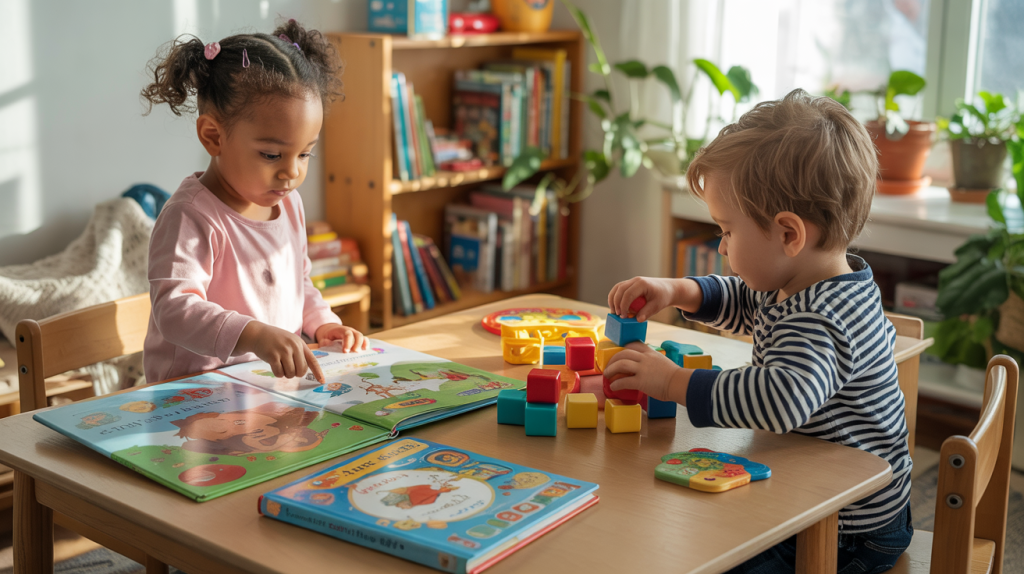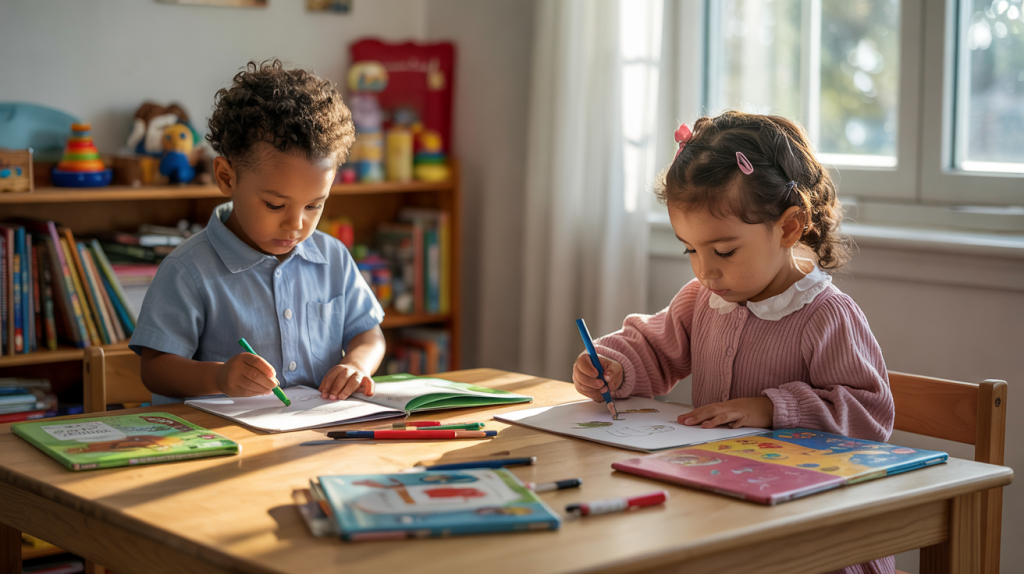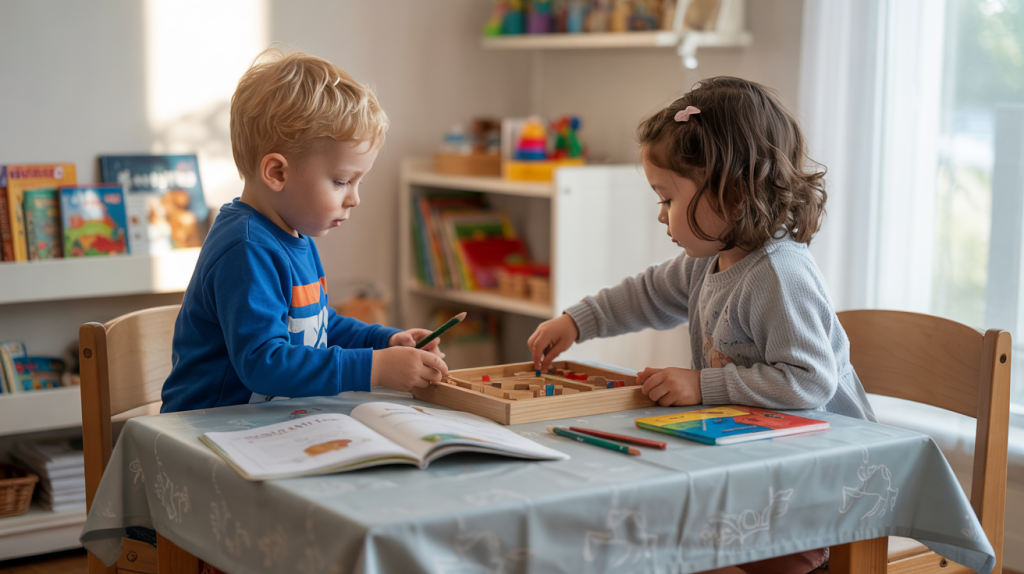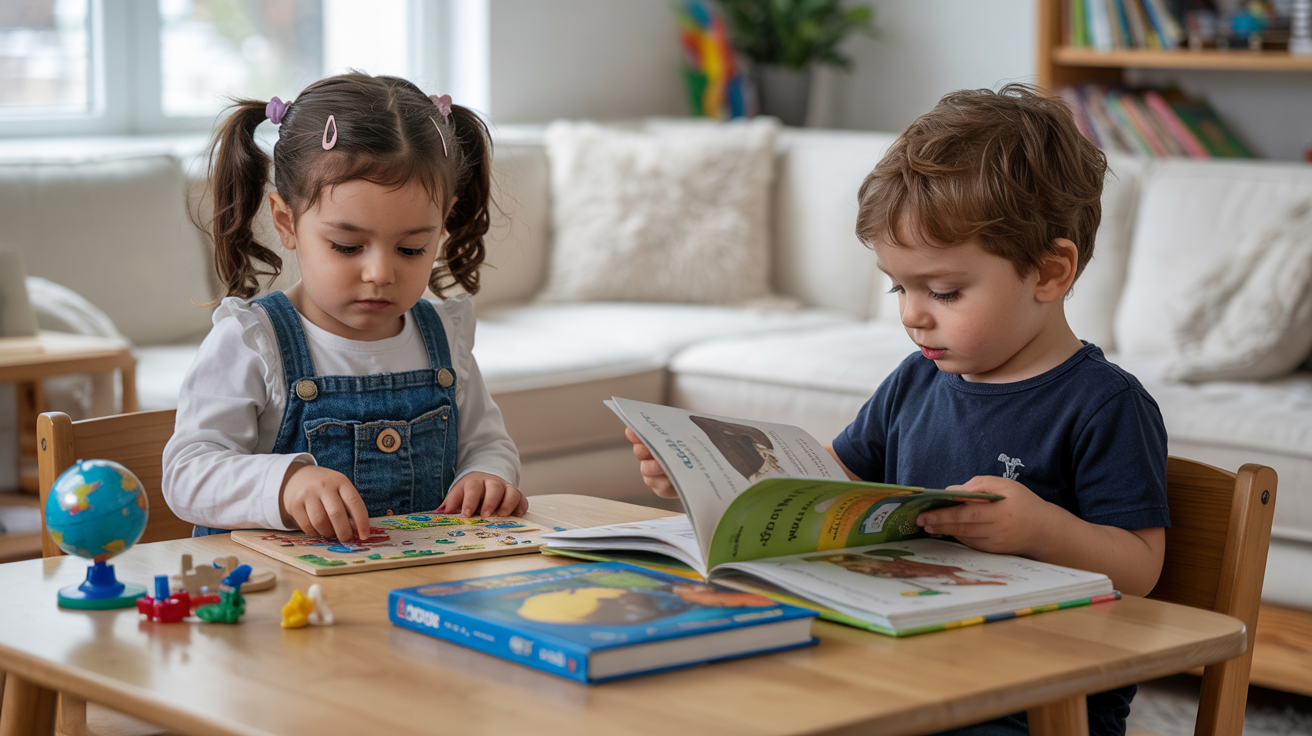Early childhood education lays the foundation for a child’s future academic success. The years before formal schooling are crucial for developing essential skills that prepare children for the classroom environment. Activities designed for young learners play a vital role in this preparation, fostering cognitive, social, and emotional growth.
Well-crafted early childhood activities serve as building blocks for school readiness. These engaging tasks help children develop critical thinking, problem-solving abilities, and social skills necessary for a smooth transition to formal education. By participating in age-appropriate activities, young learners gain confidence and become eager to explore new concepts.
The following sections will explore various aspects of early childhood education that contribute to school readiness. We’ll discuss essential skills for school preparation, literacy and math activities that boost learning, the importance of sensory experiences, and social-emotional development. Let’s discover how these activities can set your child on the path to academic success.
- What Are the Essential Skills for School Readiness?
- How Can Literacy Activities Boost School Preparation?
- Which Math-Related Activities Enhance School Readiness?
- How Do Sensory Activities Support School Preparation?
- What Social-Emotional Activities Prepare Children for School?
- Nurturing Tomorrow's Learners: A Holistic Approach
- Frequently Asked Questions
What Are the Essential Skills for School Readiness?

School readiness encompasses a range of skills that help children transition smoothly into formal education. These abilities lay the foundation for academic success and social integration. But what exactly are the essential skills for school readiness? Let’s see the key areas that contribute to a child’s preparedness for the classroom environment.
Cognitive development milestones
Cognitive skills form the backbone of learning and problem-solving. As children approach school age, their thinking abilities become more sophisticated. They start to understand basic concepts like numbers, shapes, and colors. But how can you tell if your child is meeting these milestones?
One way is to observe their play. Do they engage in pretend play, using objects to represent other things? Can they sort items by color or shape? These are signs of cognitive development. Another indicator is their ability to follow multi-step instructions, which shows their growing capacity to process and retain information.
It’s important to remember that every child develops at their own pace. However, if you notice your child struggling with basic cognitive tasks, it might be worth discussing with their pediatrician or an early childhood educator.
Social and emotional competencies
The ability to interact positively with peers and adults is crucial for school success. Social and emotional skills help children navigate the complex social environment of a classroom. These competencies include:
- Sharing and taking turns
- Recognizing and expressing emotions appropriately
- Empathizing with others
- Resolving conflicts peacefully
How can you nurture these skills at home? Playdates offer excellent opportunities for children to practice social interactions. Encourage role-playing games where your child can explore different emotions and scenarios. Reading stories about feelings and discussing characters’ experiences can also boost emotional intelligence.
Fine and gross motor skills
Physical readiness for school involves both fine and gross motor skills. Fine motor skills are essential for tasks like writing, cutting with scissors, and manipulating small objects. Gross motor skills, on the other hand, involve larger movements and are important for physical activities and sports.
To support fine motor development, offer your child plenty of opportunities to draw, color, and use playdough. Puzzles and building blocks are also excellent for improving hand-eye coordination. For gross motor skills, encourage outdoor play, dancing, and games that involve running, jumping, and balancing.
It’s fascinating to watch how these skills develop over time. A child who once struggled to hold a crayon may soon be writing their name with confidence. Celebrate these milestones, no matter how small they may seem.
Language and communication abilities
Strong language skills are vital for learning and socializing in school. Children should be able to express their needs, understand instructions, and engage in basic conversations. But what if your child is struggling in this area?
First, don’t panic. Language development varies widely among children. However, there are ways to support your child’s progress. Read to them daily, engaging them in discussions about the story. Play word games and sing songs together. Encourage them to describe their experiences and feelings.
If you have concerns about your child’s language development, consider consulting a speech-language pathologist. Early intervention can make a significant difference in a child’s communication skills.
Self-regulation and independence
The ability to control impulses, follow rules, and complete tasks independently is crucial for school success. Self-regulation allows children to sit still during lessons, wait their turn, and manage frustrations.
How can you foster these skills? Establish consistent routines at home and involve your child in setting simple rules. Encourage them to complete age-appropriate tasks on their own, such as dressing themselves or tidying up toys. Praise their efforts, not just results, to build confidence and resilience.
It’s also helpful to model self-regulation. When you’re frustrated, verbalize your feelings and demonstrate healthy coping strategies. This shows your child how to manage difficult emotions constructively.
Preparing for school is an exciting journey filled with growth and discovery. By focusing on these essential skills, you’re giving your child a strong foundation for learning and social success. Remember, every child is unique, so celebrate their individual progress and strengths along the way.
As you support your child’s development, stay attuned to their needs and interests. Engage them in activities they enjoy while gently introducing new challenges. With patience and encouragement, you’ll watch your little one blossom into a confident, capable learner ready to take on the adventures of school life.
How Can Literacy Activities Boost School Preparation?

Literacy activities play a crucial role in preparing children for school. These engaging tasks help develop essential reading and writing skills, setting the stage for academic success.
Storytelling and read-aloud sessions
Reading aloud to your child is one of the most powerful tools for language development. It exposes them to new words, sentence structures, and ideas. But how can you make these sessions more engaging?
Try using different voices for characters or asking your child to predict what might happen next. This interactive approach keeps them involved and excited about the story. You can also encourage your child to retell their favorite stories in their own words, which helps develop narrative skills.
Don’t limit yourself to books. Tell family stories or make up tales together. This creative process stimulates imagination and language skills simultaneously.
Letter recognition games
Recognizing letters is a fundamental step in learning to read. But it doesn’t have to be a boring task of memorization. Here are some fun games to try:
- Letter scavenger hunt: Look for letters in your environment (on signs, food packages, etc.)
- Alphabet soup: Float foam letters in the bathtub and fish them out while naming them
- Letter hopscotch: Draw letters instead of numbers and call out the letter to hop on
These games make letter recognition a physical, multi-sensory experience. They’re not just fun; they help cement letter shapes and names in your child’s memory.
Phonics and sound awareness exercises
Phonics involves understanding the relationship between letters and sounds. This skill is crucial for decoding words when reading. How can you introduce phonics in a playful way?
Start with simple sound games. Ask your child to find objects around the house that start with a specific sound. Or play “I Spy” with sounds instead of colors. For example, “I spy something that starts with the /b/ sound.”
As your child progresses, introduce rhyming games. Can they think of words that rhyme with “cat” or “dog”? This activity helps them recognize patterns in word sounds, a key skill in phonics.
Early writing and drawing practices
Writing and drawing are interconnected skills that support literacy development. They help children understand that marks on paper can convey meaning. But how do you encourage these practices without making them feel like work?
Provide a variety of writing tools – crayons, markers, chalk. Let your child experiment with different surfaces too, like paper, cardboard, or even the sidewalk. The goal is to make mark-making fun and accessible.
Encourage your child to “write” stories, even if it’s just scribbles at first. Ask them to tell you about their drawings. This process helps them connect spoken language with written symbols.
Vocabulary-building activities
A rich vocabulary gives children the tools to express themselves and understand what they read. But building vocabulary doesn’t have to involve flashcards or rote memorization.
One effective method is to narrate your daily activities. Use specific, varied words as you go about your day. For example, instead of just “big,” use words like “enormous,” “gigantic,” or “colossal.”
Word games can also expand vocabulary in a fun way. Play categories (name all the animals you can think of) or “opposite day” (say the opposite of what you mean). These games encourage children to dig deep into their mental word banks.
Incorporating these literacy activities into your daily routine can significantly boost your child’s school readiness. The key is to keep it fun and low-pressure. Children learn best when they’re enjoying themselves.
Which Math-Related Activities Enhance School Readiness?

Math-related activities play a crucial role in preparing children for school. These engaging tasks help develop essential numerical and logical thinking skills, setting the stage for academic success.
Counting games and number recognition
Numbers are all around us, making it easy to incorporate counting into daily life. Try counting steps as you climb stairs or objects you see during a walk. This simple activity helps children associate numbers with quantities.
For number recognition, create a scavenger hunt. Hide numbered cards around the house and ask your child to find them in order. This game combines physical activity with number learning, making it both fun and educational.
Want to make it more challenging? Try skip counting. Count by twos or fives, turning it into a rhythmic game. This lays the groundwork for multiplication skills later on.
Shape sorting and pattern identification
Shapes and patterns are fundamental mathematical concepts. To explore shapes, look for them in your environment. Can your child spot circles, squares, or triangles in everyday objects?
For pattern recognition, start simple:
- Create a pattern with colored blocks (red, blue, red, blue)
- Ask your child to continue the pattern
- Gradually introduce more complex patterns
You can also use household items like spoons and forks to create patterns. This shows that patterns exist beyond colors and shapes.
Basic addition and subtraction through play
Addition and subtraction don’t have to be intimidating. Start with concrete objects like toys or snacks. If your child has three crackers and you give them two more, how many do they have now?
For subtraction, try a “disappearing” game. Line up five toys, then ask your child to close their eyes while you remove some. How many are left? This visual approach makes subtraction more tangible.
Board games involving dice are excellent for practicing addition. As children roll and move their pieces, they’re adding without even realizing it.
Measurement and comparison activities
Measurement introduces children to important math concepts like size and quantity. In the kitchen, let your child help measure ingredients. This practical application of math shows its real-world relevance.
Comparison activities can be as simple as lining up toys from shortest to tallest. Or fill different containers with water and ask which holds more. These activities develop estimation skills and introduce concepts of volume.
For a fun outdoor activity, use a piece of string to measure various objects. How many “strings” long is the garden? The car? This introduces the concept of using standard units for measurement.
Spatial reasoning puzzles
Spatial reasoning is a critical skill for many areas of math. Puzzles are an excellent way to develop this ability. Start with simple jigsaw puzzles and gradually increase the difficulty.
Building with blocks or construction toys also enhances spatial skills. Challenge your child to build a structure that matches a picture or description. This activity combines spatial reasoning with following instructions.
For a different approach, try tangrams. These ancient Chinese puzzles involve arranging flat shapes to create specific outlines. They’re excellent for developing problem-solving skills and understanding how shapes fit together.
Math doesn’t have to be a daunting subject. By incorporating these activities into daily life, you’re helping your child build a strong foundation for future learning. The key is to keep it playful and low-pressure.
How Do Sensory Activities Support School Preparation?
Sensory activities play a crucial role in preparing children for school. These experiences help develop a child’s ability to process and respond to information from their environment, which is essential for learning and social interaction.
Tactile exploration stations
Touch is one of the first senses babies use to learn about their world, and it remains important throughout childhood. Setting up tactile exploration stations can be a fun way to stimulate this sense.
What might these stations look like? Imagine a series of containers filled with different materials:
- Dry rice or beans
- Water beads
- Shaving cream
- Kinetic sand
Encourage your child to plunge their hands into these materials, describing how they feel. Is it smooth or rough? Wet or dry? Cold or warm? This activity not only develops sensory awareness but also expands vocabulary.
You can add small toys or objects to these containers for a hide-and-seek game. This combines tactile exploration with fine motor skills as children search for hidden treasures.
Visual discrimination exercises
Visual skills are vital for reading, writing, and many other school activities. But how can you help your child sharpen these skills?
One simple activity is a matching game. Gather pairs of similar objects – two red socks, two blue blocks, etc. Mix them up and ask your child to find the matches. As they improve, increase the challenge by using objects with subtle differences.
Another idea is a “spot the difference” game. Draw two similar pictures with a few small differences and ask your child to find them. This activity hones observation skills and attention to detail.
Auditory processing games
Listening skills are crucial for following instructions and participating in classroom discussions. Auditory processing games can make developing these skills enjoyable.
Try playing “Simon Says” with a twist. Instead of just following instructions, ask your child to repeat the instruction before doing it. This helps improve both listening and memory skills.
For a different approach, play a sound identification game. Make various noises (clapping, snapping, tapping) behind a screen and ask your child to guess what made the sound. This sharpens auditory discrimination abilities.
Olfactory and gustatory experiences
While smell and taste might seem less important for school readiness, they play a role in memory formation and can support learning in subjects like science.
Create a smell guessing game using common household items like cinnamon, vanilla, or lemon. Blindfold your child and see if they can identify the scents. This activity strengthens the connection between smell and memory.
For taste experiences, try a blindfolded taste test with different fruits or safe, edible items. Can your child identify sweet, sour, salty, and bitter tastes? This activity introduces basic scientific concepts and encourages descriptive language use.
Proprioceptive and vestibular activities
Proprioception (body awareness) and vestibular sense (balance and spatial orientation) are often overlooked but are crucial for classroom behavior and physical education.
Proprioceptive activities might include:
- Animal walks (crawling like a bear, hopping like a frog)
- Squeezing through tight spaces
- Carrying heavy objects (like a laundry basket)
These activities help children understand where their body is in space, which is important for sitting still in class or navigating a crowded playground.
Vestibular activities focus on balance and movement. Try setting up an obstacle course in your backyard or living room. Include activities like walking on a line, spinning in place, and crawling under objects. These exercises improve balance and coordination, which are essential for physical education classes and playground activities.
Incorporating these sensory activities into your child’s routine can significantly boost their school readiness. The key is to make these experiences fun and engaging. You don’t need expensive equipment or elaborate setups – many of these activities can be done with everyday household items.
As you explore these sensory experiences with your child, you might notice which activities they particularly enjoy or which senses seem to need more stimulation. This information can be valuable for understanding your child’s learning style and potential needs in the classroom.
What Social-Emotional Activities Prepare Children for School?
Social-emotional skills are the foundation for successful relationships and learning in school. These abilities help children interact positively with others, manage their emotions, and navigate social situations.
Cooperative play scenarios
Imagine a group of children working together to build a towering block structure. This simple activity teaches valuable lessons in teamwork and communication. Cooperative play scenarios offer numerous benefits for school preparation.
You can set up a pretend restaurant where each child has a role – chef, waiter, or customer. This encourages children to work together towards a common goal. As they play, they learn to listen to others, share ideas, and compromise.
Another idea is a group art project. Provide a large piece of paper and ask children to create a mural together. This activity fosters creativity while teaching children to respect others’ contributions and space.
Emotion recognition and expression exercises
Understanding and expressing emotions is key to social interactions. But how can you help your child develop these skills?
Start with a simple emotion guessing game. Make different facial expressions and ask your child to name the emotion. Then, switch roles and let them express emotions for you to guess. This game improves emotional literacy and helps children recognize non-verbal cues.
Creating an “emotion wheel” can be a fun craft activity with a purpose. Draw a circle and divide it into sections, each representing a different emotion. Your child can color and decorate each section, then use the wheel to express their feelings throughout the day.
For older children, try emotion charades. Write different emotions on slips of paper and take turns acting them out without words. This game sharpens both emotional expression and recognition skills.
Turn-taking and sharing games
Taking turns and sharing are essential skills for classroom harmony. Board games naturally encourage turn-taking, but you can create other activities to practice these skills.
Set up a “sharing station” with toys or items that children need to share to complete a task. For example, provide one set of crayons for two children to color a picture together. This teaches negotiation and resource management.
A fun outdoor activity is a relay race where children must pass an object to their teammate. This combines physical activity with turn-taking practice.
Conflict resolution role-play
Conflicts are inevitable in school settings. Role-playing can help children develop strategies to handle disagreements peacefully.
Create scenarios that children might encounter in school, such as:
- Two children want to use the same toy
- Someone cuts in line
- A child feels left out of a game
Act out these situations with your child, switching roles so they can see different perspectives. Discuss possible solutions and practice using “I feel” statements to express emotions.
Self-confidence building activities
Self-confidence is crucial for school success. Children who believe in themselves are more likely to try new things and persevere through challenges.
One effective activity is creating a “success journal.” Each day, help your child write or draw something they’re proud of accomplishing. This could be as simple as tying their shoes or helping set the table. Reviewing this journal regularly reinforces a positive self-image.
Encourage your child to try new things in a safe environment. This could be tasting a new food, attempting a challenging puzzle, or introducing themselves to a new neighbor. Praise their effort, regardless of the outcome.
Another confidence-boosting activity is the “compliment circle.” Gather family members and take turns giving each person a sincere compliment. This teaches children to recognize positive qualities in themselves and others.
Implementing these social-emotional activities can significantly enhance your child’s readiness for school. The key is consistency and patience. These skills develop over time with practice and positive reinforcement.
As you engage in these activities, you might notice areas where your child excels or needs more support. This insight can be valuable for communicating with future teachers about your child’s strengths and needs.
Nurturing Tomorrow’s Learners: A Holistic Approach
As you prepare your child for school, remember that academic skills are just one piece of the puzzle. The activities we’ve explored – from literacy and math games to sensory experiences and social-emotional exercises – all work together to create a well-rounded foundation for learning. By incorporating these diverse activities into your daily routines, you’re giving your child a head start in multiple areas of development.
Your role as a parent in this journey is invaluable. Your patience, encouragement, and active participation in these activities not only prepare your child for school but also strengthen your bond. As you watch your little one grow and learn, take pride in knowing that you’re setting them up for success in school and beyond. The skills they’re developing now will serve them well throughout their educational journey and into adulthood.
Frequently Asked Questions
Q: What are some simple math activities I can do with my preschooler?
A: You can try counting games, shape sorting, and basic addition using everyday objects like toys or snacks.
Q: How can I help my child develop better social skills before starting school?
A: Engage in cooperative play scenarios, practice turn-taking games, and role-play conflict resolution situations.
Q: What types of literacy activities are best for school preparation?
A: Focus on storytelling, letter recognition games, phonics exercises, and early writing practices.
Q: How do sensory activities contribute to school readiness?
A: Sensory activities help develop processing skills, improve focus, and enhance overall learning abilities.
Q: What are some ways to boost my child’s self-confidence before school?
A: Create a “success journal,” encourage trying new things, and practice giving and receiving compliments.
Q: How can I incorporate emotion recognition exercises into our daily routine?
A: Play emotion guessing games, create an “emotion wheel,” or try emotion charades.
Q: What are some effective ways to teach sharing and turn-taking?
A: Use board games, set up “sharing stations” with limited resources, or organize relay races.
Q: How can I make learning numbers and counting more engaging for my child?
A: Try counting everyday objects, play number recognition games, or use dice in board games for addition practice.

